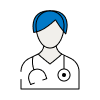A stroke happens when the blood supply to your brain is cut off. If your brain doesn't get enough blood to provide the oxygen and nutrients it needs, your brain cells will become damaged or die.
A stroke is one of the common causes of death, and also the leading cause of severe disability.
Most people who have a stroke are over 65, but many are younger than this. Anyone can have a stroke, including babies and children.
A stroke is a medical emergency, so recognising the symptoms quickly and getting treatment in hospital as soon as possible is very important.
Types of stroke
Ischaemic stroke happens when the blood supply to part of your brain is blocked by a blood clot or a piece of fatty material. This is the most common type of stroke.
Haemorrhagic stroke is caused by bleeding inside your brain. This can happen when a blood vessel bursts inside your brain or, more rarely, on the surface of your brain.
Transient ischaemic attack (TIA or 'mini-stroke') is an episode when the blood supply to your brain is interrupted for a short time. The symptoms are only temporary – they won't last for more than 24 hours.
Stroke from cervical artery dissection is caused when the lining of one of the arteries in your neck is torn, restricting the blood supply to your brain.
Causes of stroke
A stroke happens when the blood supply to your brain is cut off. This can be caused by a blood clot blocking an artery in your brain (ischaemic stroke) or a blood vessel bursting in your brain (haemorrhagic stroke). A stroke can also happen after an injury to an artery in your neck. This is called cervical artery dissection.
Risk factors for stroke include:
- older age
- smoking
- high blood pressure
- high cholesterol
- not being very active
- being overweight or obese
- diabetes
- a family history of stroke or heart disease
- an abnormal heartbeat (often a condition known as atrial fibrillation)
- conditions that cause your blood to close more slowly (for example, haemophilia)
- regularly drinking too much alcohol
- using illegal drugs, such as cocaine
Symptoms of stroke
The symptoms of stroke vary depending on what type you have and the part of your brain it affects. Symptoms usually come on suddenly, within seconds or minutes.
A good way to recognise if someone has had a stroke is to use the 'FAST' test. FAST stands for:
- Face
- Arm
- Speech
- Time to call 999
This involves checking for any one of the three main symptoms of stroke – facial weakness, arm weakness or speech problems. If you notice that someone has one or more of these symptoms, you should call for emergency help straight away.
Other common symptoms of stroke may include:
- sudden loss of sight in one or both eyes, or blurred vision
- confusion or difficulty understanding
- loss of balance or co-ordination
- severe headache
Diagnosis of stroke
You will have a number of tests in hospital to try to find out what type of stroke you had and which part of your brain has been affected. This will allow your doctor to plan your treatment.
You will have your blood pressure measured and an electrocardiogram (ECG) to record the rhythm and electrical activity of your heart. You may then have blood tests to measure your cholesterol and blood sugar levels.
You will also have a brain scan (for example, a CT or MRI) as soon as possible. This will help to find out if your stroke happened because of a bleed or a blockage.
Later on, you may have some other tests on your heart and blood vessels to find out what caused your stroke.
Treatment of stroke
When you go to hospital, you may be treated on a general ward or in a specialist stroke unit.
If you can't swallow, you will be given fluid through a drip in your arm to stop you becoming dehydrated. You will have a tube in your nose to give you the nutrients and medicines you need. You may also be given oxygen through a face mask to help you breathe.
You will be helped to sit up and move around as soon as you're able. If you can't move, you will regularly be helped to turn in your bed to reduce your risk of getting bed sores and DVT.
The length of time that you need to stay in hospital will vary and depends on how severely you have been affected by your stroke.
MedicinesThe medicine you receive will depend on the type of stroke you had. For example, if you had an ischaemic stroke or a TIA, you may be given a medicine called alteplase to break up blood clots and restore blood flow to your brain, or medicines such as aspirin or clopidogrel to prevent further blood clots. You won't be given these medicines if you had a haemorrhagic stroke as they can make bleeding worse.
You're likely to need to take medicines to control your blood pressure and possibly also to reduce the cholesterol in your blood.
SurgeryYour doctor may recommend that you have surgery. This will depend on the type of stroke you had and isn't suitable for everyone. You may have an operation to:
- remove fatty deposits from the carotid artery that takes blood to your brain (carotid endarterectomy)
- drain blood from your brain
- relieve swelling in your brain
Rehabilitation After a stroke, you may need to relearn skills and abilities, or learn new ways of doing things to adapt to the damage a stroke has caused. This is known as stroke rehabilitation.
Stroke recovery can be difficult to predict. You may find you make most of your recovery in the early weeks and months following the stroke, but recovery can continue after this time and you may carry on improving for years afterwards.
A team of health professionals that may include physiotherapists, speech and language therapists, occupational therapists, dietitians, ophthalmologists and psychologists, as well as doctors and nurses will work out a rehabilitation programme for you. This will be designed around your particular needs and will aim to help you in the long term so that you can stay as independent as possible.
Prevention of stroke
Prevention of strokeYou can take steps to lower your risk of stroke by making changes to your lifestyle. Some examples are listed below.
- Stop smoking. This can greatly reduce your risk of stroke, no matter how old you are or how long you have been smoking.
- Don't exceed the recommended alcohol limits. By cutting down the amount of alcohol you drink, you can reduce your blood pressure, which in turn lowers your risk of stroke.
- Improve your diet. Reducing how much cholesterol and salt you eat can lower your risk of stroke.
- Increase the amount of physical activity that you do – aim to do some every day. The recommended healthy level of physical activity is 150 minutes (two and a half hours) of moderate exercise over a week in bouts of 30 minutes or more.
Disclaimer
This information was published by Bupa Group's Health Content Team and has been reviewed by appropriate medical or clinical professionals. To the best of their knowledge the information is current and based on reputable sources of medical evidence, however Bupa (Asia) Limited makes no representation or warranty as to the completeness or accuracy of the Content.
The information on this page, and any information on third party websites referred to on this page, is provided as a guide only. It should not be relied upon as a substitute for professional medical advice, nor is it intended to be used for medical diagnosis or treatment. Bupa (Asia) Limited is not liable for any loss or damage you suffer arising out of the use of, or reliance on, the information.
Third party websites are not owned or controlled by Bupa and any individual may be able to access and post messages on them. Bupa is not responsible for the content or availability of these third party websites. Last updated August 2017.









